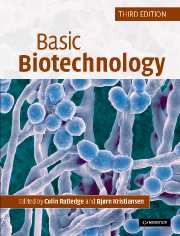Book contents
- Frontmatter
- Contents
- List of contributors
- Preface to the second edition
- Preface to the third edition
- Part I Fundamentals and principles
- Part II Practical applications
- Chapter 12 High-throughput screening and process optimisation
- Chapter 13 The business of biotechnology
- Chapter 14 Amino acids
- Chapter 15 Organic acids
- Chapter 16 Microbial polysaccharides and single cell oils
- Chapter 17 Environmental applications
- Chapter 18 Production of antibiotics by fermentation
- Chapter 19 Strategies of cultivation
- Chapter 20 Enzyme biotechnology
- Chapter 21 Recombinant proteins of high value
- Chapter 22 Insect and mammalian cell culture
- Chapter 23 Plant cell biotechnology
- Chapter 24 Biotransformations
- Chapter 25 Immunochemical applications
- Index
Chapter 21 - Recombinant proteins of high value
Published online by Cambridge University Press: 05 June 2012
- Frontmatter
- Contents
- List of contributors
- Preface to the second edition
- Preface to the third edition
- Part I Fundamentals and principles
- Part II Practical applications
- Chapter 12 High-throughput screening and process optimisation
- Chapter 13 The business of biotechnology
- Chapter 14 Amino acids
- Chapter 15 Organic acids
- Chapter 16 Microbial polysaccharides and single cell oils
- Chapter 17 Environmental applications
- Chapter 18 Production of antibiotics by fermentation
- Chapter 19 Strategies of cultivation
- Chapter 20 Enzyme biotechnology
- Chapter 21 Recombinant proteins of high value
- Chapter 22 Insect and mammalian cell culture
- Chapter 23 Plant cell biotechnology
- Chapter 24 Biotransformations
- Chapter 25 Immunochemical applications
- Index
Summary
Applications of high-value proteins
Proteins used in industrial enzyme technology, e.g. detergent proteinases or enzymes applied in the food industry, are in most cases rather crude preparations and usually mixtures of different enzymes. In contrast, there are a number of commercial applications where highly purified (and therefore high-value) proteins are needed. Examples are:
Analytical enzymes and antibodies: Used in medical diagnostics, food analysis, as well as biochemical and molecular biological analysis (see Section 21.2).
Enzymes used as tools in genetic engineering technology: Gene technology has become possible through the availability of highly purified restriction endonucleases, DNA and RNA polymerases, nucleases and modifying enzymes (see Chapters 4 and 5). Similarly, glycohydrolases and glycosyl transferases are used increasingly in glycobiotechnology in order to modify the sugar residues of glycoproteins.
Therapeutic proteins: Growth factors, antibodies and enzymes are used as the active drug ingredients for the treatment of diseases (see Section 21.3).
Furthermore, proteins with proven or supposed biological relevance in pathomechanisms are needed as targets for the search of new ligands (agonists or antagonists) or inhibitors and for X-ray or nuclear magnetic resonance (NMR) structural analysis in order to design novel interacting compounds by structure-based molecular modelling. This requires the production of these proteins on a relatively small scale (10 to 100 mg), but often with high purity depending on the intended use.
Analytical enzymes
Enzymes are highly specific both in the reaction catalysed as well as in their choice of substrates.
Information
- Type
- Chapter
- Information
- Basic Biotechnology , pp. 499 - 522Publisher: Cambridge University PressPrint publication year: 2006
Accessibility standard: Unknown
Why this information is here
This section outlines the accessibility features of this content - including support for screen readers, full keyboard navigation and high-contrast display options. This may not be relevant for you.Accessibility Information
- 1
- Cited by
